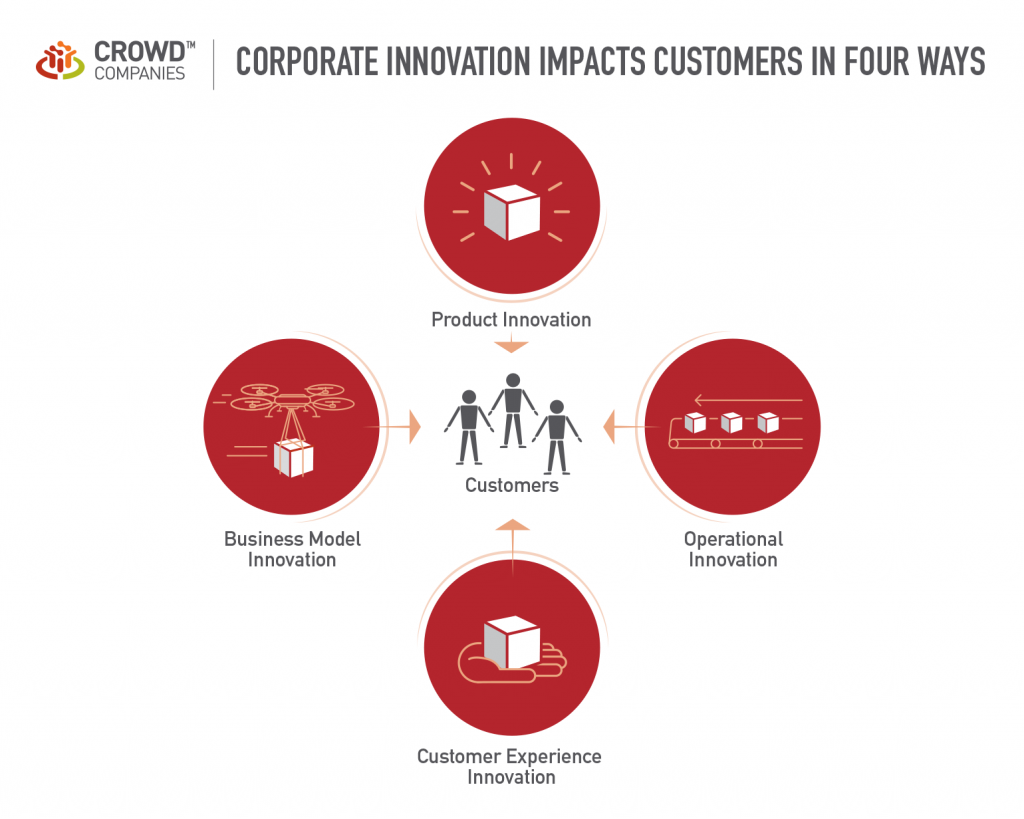Rather than arbitrarily throw around the “innovation” word, understand how it impacts your customers, and be specific. Innovation comes in four flavors: product innovation, operational innovation, customer experience innovation, and business model innovation.
Corporate innovation isn’t easy. Stefan Petzov, an innovation professional at Swisscom, a Crowd Companies member, has outlined the many challenges that innovation programs inherently face. In particular, the first challenge he lists out is that companies struggle because “the expected outcome is not clearly defined.” Clarity is paramount.
One way to solve this top-level challenge is to ensure your company and innovation partners have a standard nomenclature for how innovation is used. We looked at structuring this language around products, business units, or functions, but found it would be most helpful to structure it around customer benefit.
First, some qualifications on the scope of this discussion: The following is focused on how innovation is done within a company, not about external activities like partnerships, investment, acquisition, accelerators, and more. In a recent post, we identified the ten types of innovation programs, which goes into a bit more detail.

Corporate Innovation Impacts Customers in Four Ways:
| Innovation Categories | Description | Examples | Benefits to Customers |
| 1) Product Innovation | Often led by R&D, product features are enhanced, or new products are developed based on the product roadmap. | Nike evolved beyond shoes to Nike Plus, expanding its offerings. Also, new product lines like Nestle’s launch of Nespresso grew a loyal customer base. | Continued improvements on product features and benefits, as well as new product lines. |
| 2) Operational Innovation | Often led by operations, new processes increase productivity and efficiency, or reduce costs associated with employees, partners, and the supply chain. | In the ’70s, Japanese automakers like Toyota and Honda increased the efficiency of auto production and reduced overall costs through kaizen. | Products emerge faster, with more consistency, and often at a lower cost. |
| 3) Customer Experience Innovation | Often led by marketing and customer care, new services, interfaces, and channels are developed to improve customer interactions, while the product often stays the same. | Hugo Boss partnered with Uber for product delivery, transportation, and concierge. Swisscom launched “Friends” so customers can self-support. | New services beyond the core product offering, including supportive media, communications in new channels and mediums, and white-glove service. |
| 4) Business Model Innovation | Often led by innovators or strategists, companies identify complete new revenue streams from existing core capabilities. | BMW launched ReachNow, enabling customers to rent vehicles on demand – rather than buy – packaged with parking services, insurance, and more. | Core product and service offerings are provided in new ways that meet shifting customer expectations –reframing customer relationships in the face of disruptive technologies. |
With new technologies emerging at a rapid pace (who knew Pokemon Go would be a top app within just a few days), companies have no choice but to accelerate their rate of innovation. Unfortunately, most companies focus exclusively on only one or two forms of corporate innovation, forgetting others that could be a key competitive advantage to satisfying the ever-changing expectations of customers.
Most companies focus on Product Innovation, which can quickly escalate into a race amongst competitors towards a commoditization that churns out less-than-useful new products rather than true innovation that revolutionizes the way customers live. In recent periods, I’ve also observed companies redeploy attention on Customer Experience Innovation as they scramble to reach customers in a multitude of digital and in-person channels.
An area we focus heavily on at Crowd Companies is how companies tap into the power of people and technology to unlock new revenues by serving customers in new ways through Business Model Innovation, whether that’s in the Collaborative Economy or the Autonomous World, where robots take the wheel, and whatever comes next.
To maximize customer satisfaction – and ultimately competitive edge – companies must innovate in all four of these areas, as well as ensure that the innovation management team is coordinating all efforts toward a single goal.
In closing, when you’re using the word innovation, be clear about which of the four types you’re referring to, as it impacts your company, employees, and customers in significant ways.
(Credit to Jairo Venegas for the focus on operational innovation, and Jamie Sandford for the link to the Science of Innovation.)
For innovation to be more than just a word, it has to be aligned with the priorities of the business and the customers. The segmentation is good, but if we aren’t talking to our customers early on, then it doesn’t matter how you segment it, your customers won’t buy it.
Thank you Craig, you’ve reinforced the points.
Thank you so much for post a blog about corporate. You says correctly and i agree with you that these causes are involved with success in a business. So we need to be careful of these tips.